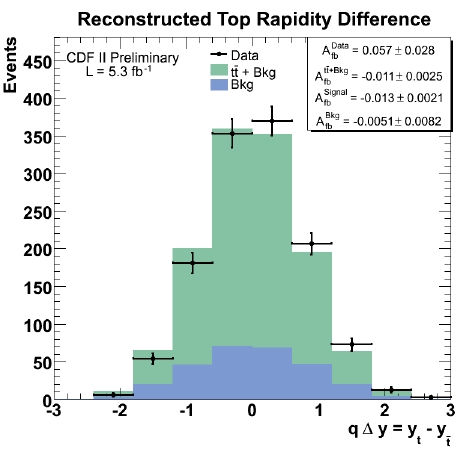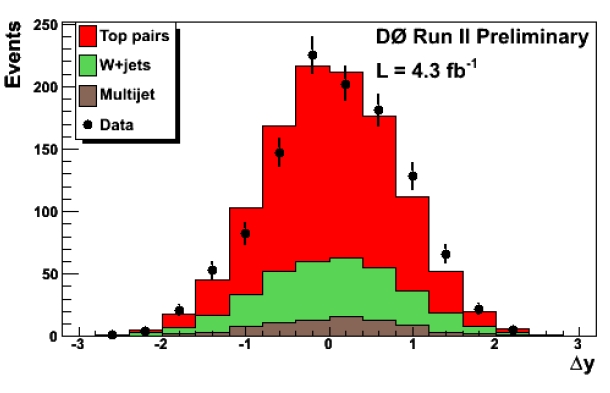Top quarks are produced by the energetic interaction of a quark and an antiquark, or a pair of gluons. The high energy required for the creation of two top quarks guarantees that we can calculate with precision the rate and the features of their production, using the knowledge of quantum chromodynamics (QCD), the theory of the strong force that keeps nuclei together and that governs the interaction of their constituents: quarks and gluons.
By measuring the observed characteristics of events featuring top quark decay signals, we can verify very cleanly the detailed theoretical predictions. This is what CDF and DZERO have been doing for 15 years: first by measuring the production rate; then by determining the decay modes of top quarks; then by looking for resonant production of top pairs, by searching for single top production, by measuring directly the top quark spin, the charge, etcetera.
One thing that has been accessed with precision only with the recent wealth of analyzable data is the production asymmetry. This is basically a measure of how frequently the (anti-)top quark prefers to be emitted in the direction of the colliding (anti-)proton. Theory predicts that there should indeed be a small asymmetry in the production of top pairs by proton-antiproton collisions, but this asymmetry is entirely ascribed to second-order effects: at leading order the strong force should behave perfectly oblivious of the electric charge of the quarks. You might think of it as due to the fact that as far as colour charge is concerned, top and antitop quarks are the same particle.
Previous measurements of the top asymmetry had shown some disagreement with predictions, but error bars were still large (I discussed the matter briefly here). Now, however, CDF made public a more precise analysis which utilizes over five inverse femtobarns of collisions, resulting in a dataset of over a thousand well-reconstructed top pair production events. And recently, DZERO also analyzed a similarly sized dataset, in search of their own precise determination of the top asymmetry. And what have the two experiments found ?
The results are quite interesting: both experiments find a significant asymmetry, larger than what is expected by theoretical calculations. CDF finds a laboratory-frame parton-level asymmetry of 0.150+-0.055, when theory predicts 0.038+-0.006. DZERO instead finds a reconstructed asymmetry of 8+-4%, while 1+-2% would be expected by simulations.
A technical note is needed here: the two results cannot be directly compared. That is because CDF reduces the observation to a parton-level asymmetry to compare to a direct theoretical calculation, while DZERO does the opposite, passing the theory through a simulation of the reconstruction. Still, the two results agree in the essence: the production of top quarks is more asymmetric than what our present-day theoretical tools allow us to predict. This is evident if you compare the CDF and DZERO distributions of the top quark rapidity difference, below.

Above, the CDF result with 5.3 inverse femtobarns of collisions. The black points are experimental data, and the two histograms stacked one atop the other are top production (in green) and background events (in blue). The black points "lean" to the right, which is the observed asymmetrical behaviour.
And below, look at the DZERO distribution of 4.3 inverse femtobarns of top pair candidates. Here top is in red, and two different backgrounds are shown below it. Again, the black points lean to the right: positively-charged top quarks tend to be emitted preferentially in the proton direction, if ever so slightly.

The discrepancy is at the level of two standard deviations (a one-in-twenty chance) in both cases, so it is not significant enough to get particle physicists excited about new physics lurking in the production of top quarks: however, two plus two is almost three...
...Almost. Because if some systematic effect is causing one experiment to measure an asymmetry in top production, it is quite possible that the same effect affects also the other experiment lying a third of the ring away! These days I tend to enrich my posts with such sobering remarks, given the fact that I have -unjustly, I feel- fingered as a over-hyper of insignificant deviations of high-energy physics results from expectations. I think it is useful to keep the excitement high for the physics that the Tevatron collider is producing, but I still have to make my beliefs clear: I do not think these results are an indication of new physics! And further, let me also add my disclaimer of liability, to explain that I am speaking on behalf of nobody but myself only in this article:
I do disclaim thee, o Liability!Ok - today's form of my disclaimer would not go very far in a libel cause, but it is a way to remember a friend, so allow me an eccentric twist.




Comments